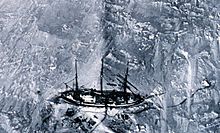
CCGS Amundsen is a Pierre Radisson-class icebreaker and Arctic research vessel operated by the Canadian Coast Guard. The vessel entered service in 1979 as Franklin and was renamed Sir John Franklin in 1980 and served as such until 1996. Declared surplus, the vessel was used as an accommodation ship in Labrador in 1996 and placed in reserve in 2000. In 2003, the ship was reactivated and underwent conversion to an Arctic research vessel. The ship recommissioned as Amundsen.

CCGS Labrador was a Wind-class icebreaker. First commissioned on 8 July 1954 as Her Majesty's Canadian Ship (HMCS) Labrador in the Royal Canadian Navy (RCN), Captain O.C.S. "Long Robbie" Robertson, GM, RCN, in command. She was transferred to the Department of Transport (DOT) on 22 November 1957, and re-designated Canadian Government Ship (CGS) Labrador. She was among the DOT fleet assigned to the nascent Canadian Coast Guard (CCG) when that organization was formed in 1962, and further re-designated Canadian Coast Guard Ship (CCGS) Labrador. Her career marked the beginning of the CCG's icebreaker operations which continue to this day. She extensively charted and documented the then-poorly-known Canadian Arctic, and as HMCS Labrador was the first ship to circumnavigate North America in a single voyage. The ship was taken out of service in 1987 and broken up for scrap in 1989.

CCGS Bartlett is a Provo Wallis-class buoy tender in operation by the Canadian Coast Guard. The vessel entered service in 1969 and was modernized in 1988. In 1982, the ship commanded the recovery efforts following the Ocean Ranger sinking off the coast of Newfoundland. The vessel is assigned to the Pacific Region and is based at Victoria, British Columbia.
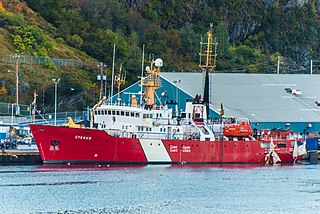
CCGS Cygnus is a Cape Roger-class fisheries patrol vessel of the Canadian Coast Guard. The ship entered service in 1981 and is used to monitor the fisheries along the Atlantic coast of Canada. During the Turbot War, Cygnus was among the Coast Guard vessels sent to monitor the European fishing fleet on the Grand Banks.
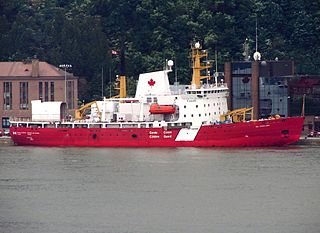
CCGS Des Groseilliers is a Pierre Radisson-class icebreaker in the Canadian Coast Guard. The vessel is named after Médard Chouart des Groseilliers (1618–1669) a close associate of Pierre-Esprit Radisson in explorations west of the Great Lakes and the founding of the British Hudson's Bay Company. The ship entered service in 1982. The vessel has participated in a number of research voyages, including Ice Station SHEBA. As part of the Surface Heat Budget of the Arctic Ocean experiment conducted in the Arctic Ocean from October 1997 to October 1998 to provide polar input to global climate models, Des Groseilliers was allowed to be frozen into the ice for the Arctic winter, to serve as a base for scientific researchers.
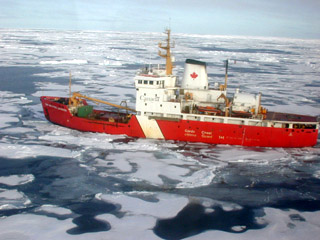
CCGS Sir Wilfrid Laurier is a Martha L. Black-class light icebreaker and major navaids tender of the Canadian Coast Guard. Built in 1986 by Canadian Shipbuilding at Collingwood, Ontario, Canada, she was the last ship constructed there. The ship has been based out of Victoria, British Columbia.

CCGS Hudson was an offshore oceanographic and hydrographic survey vessel operated by the Canadian Coast Guard. The ship entered service in 1963 with the Canadian Oceanographic Service, stationed at the Bedford Institute of Oceanography, called CSS Hudson. The ship made several significant scientific voyages, among them the first circumnavigation of the Americas in 1970. The ship was transferred to the Canadian Coast Guard in 1996 and decommissioned in 2022. A replacement is not scheduled for delivery until 2024–2025.

CCGS John A. Macdonald was a Canadian Coast Guard heavy icebreaker. She was named after The Right Honourable, Sir John Alexander Macdonald, the first Prime Minister of Canada. The ship was commissioned into the Canadian Department of Transport's Marine Service in 1960 using the prefix "Canadian Government Ship" (CGS). The vessel was transferred in 1962 into the newly created Canadian Coast Guard (CCG) and served with distinction until being decommissioned in 1991, and replaced by the then-chartered CCGS Terry Fox.

The Polar 8 Project was a Canadian shipbuilding project intended to provide the Canadian Coast Guard with a large and heavy class icebreaker capable of operating year-round in the Northwest Passage. The project was developed as a means to assert Canada's sovereignty in the Arctic Ocean. It commenced in 1985 but was cancelled in 1990 while still in the final design stage. It was Canada's direct response to the unauthorized transit through the Northwest Passage in summer 1985 by USCGC Polar Sea, a United States Coast Guard icebreaker. Polar 8 refers the capability of the ship in ice of that thickness in feet, in this case 8 feet (2.4 m).

CCGS N.B. McLean was a Canadian Coast Guard icebreaker. Constructed in 1930 at Halifax Shipyards, she entered service as CGS N.B. MacLean and served in the Department of Transport's Marine Service, using the prefix "Canadian Government Ship". The ship was transferred into the newly created Canadian Coast Guard in 1962. She served in the St. Lawrence River and Gulf of St. Lawrence until she was decommissioned in 1979, and taken to Taiwan to be scrapped in 1989. She was replaced by CCGS Pierre Radisson.

CCGS D'Iberville was a Canadian Coast Guard icebreaker that was in service from 1952 to 1983 and was Canada's first modern icebreaker. The ship commissioned as CGS D'Iberville for the Department of Transport's Marine Service, using the prefix "Canadian Government Ship", D'Iberville was transferred into the newly-created Canadian Coast Guard in 1962. When launched, she was the largest icebreaker in use by Canada post-World War II until CCGS John A. Macdonald was put in service. In 1984, the icebreaker was renamed Phillip O'Hara before returning to her old name in 1988. In 1989 the vessel was sold for scrap and broken up at Kaohsiung, Taiwan.
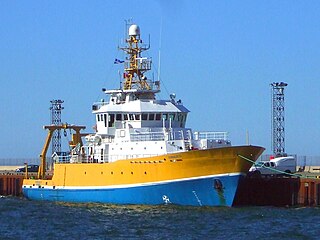
Coriolis II is a Canadian research vessel. She is homeported in Rimouski, Quebec. She is operated by a consortium of five institutions: Institut des sciences de la mer à Rimouski (ISMER), the Université du Québec à Montréal (UQAM), McGill University, the Institut national de la recherche scientifique - Eau, terre et environnement (INRS-ETE) and the Maurice Lamontagne Institute (MLI-DFO). The vessel was constructed in 1990 by Versatile Pacific Shipyards of Esquimalt, British Columbia for the Canadian Coast Guard. Initially named CCGS John Jacobson, the vessel was deployed for search and rescue missions along Canada's coastlines. The Canadian Coast Guard took John Jacobson out of service in 1999 and sold the ship to her current owners in 2001.

CCGS Pierre Radisson is the lead ship of her class of icebreakers. Constructed and operated by the Canadian Coast Guard, the vessel is based at Quebec City on the Saint Lawrence River. The ship was constructed in British Columbia in the 1970s and has been in service ever since. The vessel is named for Pierre-Esprit Radisson, a 17th-century French fur trader and explorer.
CCGS Wilfred Templeman was a Canadian Coast Guard fisheries research vessel that entered service 1981 with the Department of Fisheries and Oceans. In 1995 the Fisheries and Oceans and Canadian Coast Guard fleets were amalgamated and Wilfred Templeman joined the Canadian Coast Guard. The research vessel patrolled the coast off Newfoundland and Labrador. In 2011, the vessel was taken out of service, sold to commercial interests and renamed Blain M.

CCGS Sir Humphrey Gilbert is a former Canadian Coast Guard light icebreaker and buoy tender that was later sold to a private owner and renamed Polar Prince. The ship entered service with the Department of Transport Marine Service in 1959 and transferred to the newly created Canadian Coast Guard in 1962, active until 2001. The icebreaker was sold to private interests in Newfoundland and renamed Polar Prince, sitting mostly idle until resold in 2009 to GTX Technology Canada Limited for service in the Arctic Ocean as a commercial icebreaker. In 2017, the vessel was temporarily rechristened Canada C3 and used for a high-profile voyage around Canada's three maritime coasts as part of the nation's 150th anniversary. In November 2021, the ship was purchased by Miawpukek Horizon Maritime Service Ltd, a joint venture between Horizon Maritime and the Miawpukek First Nation and chartered for educational and research expedition use.

CCGS Tracy was a Marine service vessel and navigational aid tender operated by the Canadian Coast Guard. Designed for service on the Great Lakes and the Saint Lawrence River, the ship joined the fleet in 1968 and was stationed at Canadian Coast Guard Base at Sorel, Quebec and serviced the Quebec Region. The vessel was taken out of service in 2013 and was sold in 2017 to private interests.

CGS Stanley has been described as Canada's first effective icebreaker. She was launched in 1888, and remained in service until 1935. Constructed in the United Kingdom, Stanley was deployed along the East Coast of Canada for use as a ferry and lighthouse and buoy supply vessel and was used for icebreaking during winter months.
CCGS J.E. Bernier was a Canadian Coast Guard medium Arctic icebreaker with a steel hull. The vessel was in service from 1967 to 2006. The ship was initially based at Quebec City but finished her career at St. John's. The ship was named for Joseph-Elzéar Bernier, captain of CGS Arctic which explored and monitored the eastern Arctic for the Government of Canada in the early 20th century. The vessel was sold in 2006 to private interests.

The Samuel Risley-class icebreakers are a class of two icebreakers and buoy tenders constructed for and operated by the Canadian Coast Guard. The two ships are based on offshore supply tugboat design and entered service in the 1980s. Samuel Risley is deployed to the Central Region, operating mainly on the Great Lakes of North America, while Earl Grey is posted to Atlantic Canada, working off the east coast of Canada.

The Pierre Radisson-class icebreakers, also known as R-class icebreakers, are a class of four icebreakers constructed for and operated by the Canadian Coast Guard. The Canadian Coast Guard designates the four ships in the class as medium icebreakers. Built in two phases, the first three ships, Pierre Radisson, Franklin and Des Groseilliers, were built to a common design. The fourth, Henry Larsen was built to a modified design and is considered a subclass, the Improved R-class icebreaker. Franklin was later renamed Sir John Franklin before undergoing a re-design for use primarily as an Arctic research vessel. Upon the vessel's return to service, the ship was once again renamed Amundsen. All the vessels are named for people who sailed through Canada's northern waters. The class operates in the Arctic Ocean in the summer, patrolling, icebreaking and research missions.


